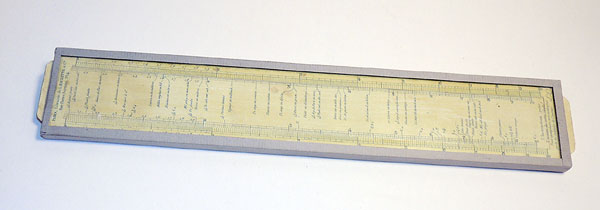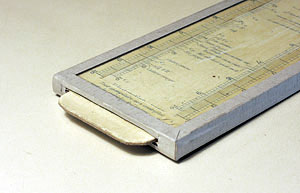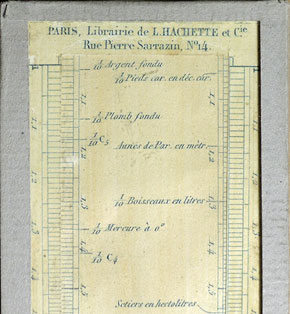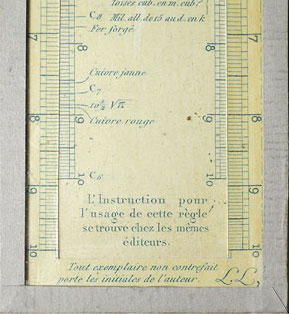 Up
Up
|
|

|

|
Lalanne's glass slide rule |
|
|
|
|
The phrase “Out of the Box thinker” is of twentieth century vintage, but Léon Lalanne certainly was such a thinker back in the nineteenth. He demonstrated this quality in 1851, when he invented a logarithmic slide rule for the use of high school pupils that was made entirely of paper and glass. |
|
|
|
 Click photo to enlarge |
|
|
|
This unorthodox choice of glass would seem,
at first, to be an absurd idea: surely there are more durable
materials to put into the hands of children? And yet there was a
method to this madness, and Lalanne explains the matter in a notice
in the March 8, 1855 issue of Revue de l’Instruction Publique
(available
here on Gonzalo Martin’s
Photocalcul
site): “When the description and properties of the slide rule entered classical education for the first time, the making of this instrument was hampered by accidental circumstances. The shortage of wooden rules at the time, and the impossibility of improvising or even completing in a short time the very expensive devices that are necessary for good manufacturing with this material, were the origin of the new rule with a glass envelope”. What happened is that after decades of English head start the French were beginning to adopt the slide rule, much to Lalanne’s satisfaction; and around mid-century the French education system had included slide rule use in the curriculum of technical high schools. To that end students had to be equipped with the devices, presaging in a way the “computer for every child” drives of a later day. However, there was a supply problem: at the time France had excellent slide rule makers, such as the Gravet-Lenoir firm, but these makers were using boxwood – which required precise and costly processing. This was okay for equipping engineers and scientists, but “every child” would far exceed their output. Eager to find a workaround, Lalanne figured a way to mass-produce precision slide rules without any wood in them, and at a much lower cost. Construction: |
|
|
|
This is a slide rule whose paper scales and cardboard slide are sandwiched between two layers of plate glass, held together by an paper tape at the edges. In a sense it is a slide chart whose outer shell – its stator – is made of paper instead of cardboard, with the missing rigidity provided by the glass “envelope” referenced in the French name of the device. This allows the stator to be paper-thin, eliminating the parallax that renders slide charts less accurate. |
 Click photo to enlarge |
|
|
|
The slide rule is two-sided, but has no
cursor (you’d need to put one under the glass, where you couldn’t
move it!). Without a cursor, it must maximize the number of
slide/stator scale interfaces (as I’ve explained
here). The front side has two narrow full-length cutouts in the
stator to allow four such interfaces, as in a two-slide rule; the
back has a wide cutout providing two interfaces. In the notice mentioned above Lalanne gives a list of the glass rule’s advantages over the wooden version (while admitting that the latter is less fragile). These include the 50% reduction in cost, but also various technical advantages, from the improved clarity of the printed scales to the ability to add by hand user-defined gauge points to the slide. He claims to have overcome the problem seen in early units of the slide contracting relative to the stator, so my unit must be an early one – the slide’s scales are shorter by about 0.5 mm. It is interesting to compare this slide rule to the ALKU, the other paper-and-glass slide rule in my collection. Working in Germany just after WW2, Alfred Kuhmann was most likely forced to use glass due to the scarcity of better materials; but his approach was different from Lalanne’s. The ALKU is a “regular” slide rule, with a slide moving in a groove in the stator; the slide and stator are all made of paper-coated glass strips, and the scales are printed on the paper. In fact you can’t even see the glass at first glance. Lalanne has the paper inside the glass, which is very visible indeed! Scales: |
|
|
|
 Click photo to enlarge |
|
|
|
 Click photo to enlarge Front (top) and back of the slide rule |
|
|
|
The front side of the rule has two
full-length cutouts in the stator, through which the slide can be
seen. Each cutout has a scale at each edge and one scale visible on
the slide. The top cutout is dedicated to the trig functions –
angles for sines and cosines on the scales above it and for tangents
and cotangents below, with the results shown on a two-cycle log
scale on the slide. The bottom cutout has two-cycle log scales above
and on the slide and a one-cycle scale below. This takes care of
multiplication, division, squares and square roots – the basic
business of a slide rule. It is worth noting that the arrangement of scales in this bottom cutout – A[B|B]D, in the modern notation – is the same as on the “Soho” slide rule invented in England in the late 18th century by James Watt. French instrument makers had readily copied the English design and were producing it (in wood, remember) at the time Lalanne designed his glass-enveloped rule. Coincidentally, he’s done that in the very year – 1851 – that Amédée Mannheim introduced the cursor that would render the Soho obsolete. The back of the Lalanne slide rule has a very wide cutout with one-cycle logarithmic scales all around – two at the stator edges and two on the slide. The main feature is what’s in the wide strip in the middle: dozens of gauge marks, captioned points on the scale denoting various useful constants. In addition to multiples of pi and the like, there are constants that facilitate conversions between English and French measures, and others for the specific gravity of various metals. Such constants are listed on the back of many wooden slide rules of the period, but having them marked directly on a movable slide allows for direct computation, reducing the chance of error. |
|
|
|

 Click a photo to enlarge Close-up on the two ends of the back side of the rule |
|
|
|
You can find excellent hi-res copies of the
scales (and instructions for creating a full reproduction of the
rule) on the site of the ARC (Spanish slide rule fan club)
here and
here The inventor: Léon Lalanne (1811–1892) was a man of many
talents. He was an accomplished mathematician, civil engineer and
innovator, as well as a politician. His main claim to fame may be
the co-invention (with Philbert Maurice d'Ocagne) of the Nomogram.
His activities and honors are too numerous to list here, but a
Wikipedia
article does the job. |
|
|
|
Exhibit provenance: I bought this item from the estate of the late Robert K. Otnes. Bob was a founder and mainstay of the Oughtred Society, a great collector, and a wonderful person; I’ve admired his collection – and his friendliness – when visiting his home in Palo Alto. I would value the Lalanne slide rule in any event, but I cherish it even more as a memento of my friendship with Bob. More info:
|
|
|
|
|
|
|
|
Home | HOC | Fractals | Miscellany | About | Contact Copyright © 2020 N. Zeldes. All rights reserved. |
|